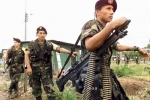Members of one of the most militarized drug-trafficking groups in Colombia are now being recruited by the Revolutionary Armed Forces of Colombia (Fuerzas Armadas Revolucionarias de Colombia – FARC), reports a Colombian think-tank. This underlines a trend which InSight has observed across Colombia: the deepening of the FARC’s alliances with criminal bands, descended from their one-time rivals, the right-wing paramilitaries.
The Popular Revolutionary Antiterrorist Army of Colombia (Ejerctico Revolucionario Popular Antiterrorista Colombiano – ERPAC) suffered the loss of its top commander, Pedro Oliveiro Guerrero, alias “Cuchillo,” last December, when elite police troops raided his home on Christmas eve. Now, El Tiempo reports that at least 40 ERPAC members have gone over to work for one of the FARC’s wealthiest and most powerful units: the First Front, which at one time held former presidential candidate Ingrid Betancourt hostage in the department of Guaviare.
Cuchillo sent a comission of people to Guaviare to colonize a route for transporting coca,” a representative from think-tank Nuevo Arco Iris told El Tiempo. “That comission ended up with the FARC. We’re talking about at least 40 people who changed their ERPAC badge for one from the FARC.”
This echoes speculation previously made by a police officer who helped bring down Cuchillo, who told El Espectador that ERPAC deserters could possibly swell the First Front’s ranks by hundreds of fighters. The First Front is currently believed to number 390 combatants, and is active in the municipalities of Calamar, Barranquillita and Miraflores in Guaviare, where some of the densest coca cultivations in Colombia are found.
Guaviare is one of Colombia’s most rural and isolated departments, with little military presence or infrastructure. If the ERPAC has deepened their alliance with the FARC here, no longer just buying coca base from the First Front but also conducting joint operations, it might have little impact on national security but could have huge implications for the future of the conflict.
What would be especially troublesome for the government is if the ERPAC began fighting alongside the FARC in Meta, an oil-rich department where the government is carrying out one its most important offensives against the guerrillas. Meta was the focal point of President Alvaro Uribe’s “Democratic Security” policy and is home to the Joint Task Force Omega, responsible for some of the most devastating blows against the FARC’s Eastern Bloc. If Fronts like the 26th and 27th begin coordinating more closely with the ERPAC in trafficking arms, drugs, and basic supplies, this would provide a much-needed boost for the weakened Eastern Bloc and could further challenge the military’s advance in this key department.
InSight Crime has hear no evidence that the FARC is recruiting ERPAC members either in Meta or Vichada, where the 16th Front is also known to sell coca base to Cuchillo’s men. Thanks to a business agreement negotiated by drug trafficker Daniel Barrera, alias “El Loco,” the ERPAC has bought coca base from several FARC Fronts since 2009, even though the two groups previously were bitter enemies.
If the two organizations were to begin sharing manpower, this would indicate a symbiosis between the left-wing guerrillas and their former enemies, the paramilitary fighters who make up ERPAC’s ranks. Colombia has already seen other cases of the FARC working increasingly alongside Colombia’s criminal bands in Cauca, Cordoba, Putumayo and Antioquia. Both the BACRIMs and the guerrillas have been forced to get into the same bed thanks to the government’s ongoing military offensive, which has seen the elimination of top commanders like Cuchillo and the FARC’s military commander, Jorge Briceño Suarez, alias “Mono Jojoy.”
These military victories against the illegal armies, the decapitation of their top levels of command, are encouraging both the FARC and the BACRIMS to deepen their relationship in the common interest of drug trafficking. If these business agreements turn into military alliances, the government will face an even tougher time pacifying the country. In a worst-case scenario, the future of the Colombian conflict would involve the fusion of the FARC with the ERPAC in the Eastern Plains, with the Rastrojos in the southwest, and with the Paisas and Urabeños in the north. The battlefield will become even more fractured, volatile and violent than it is now.
The FARC have become deeply entrenched in drug trafficking although they still espouse a political agenda. But if the criminalization of the FARC continues and there are further reports of BACRIM-guerrilla collaboration, as is the case with Guaviare, the prospect of a political, negotiated solution to the conflict could become still more complicated.

